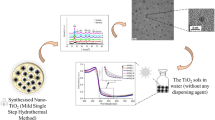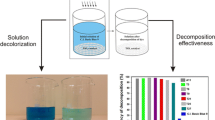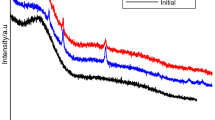Abstract
In this work the effect of pH and the titanium precursor on the cluster and particle formation during titanium alkoxide based sol–gel processes was investigated using electrospray ionization mass spectrometry (ESI-MS) and dynamic light scattering (DLS). The influence of pH and the titanium precursor on the particle size, morphology, crystallinity and chemical composition of the resulting particles were investigated using differentiel scanning calometry (DSC), X-ray diffraction (XRD), Fourier transformation infrared spectroscopy (FT-IR), BET-adsorption isotherms and high resolution transmission electron microscopy (HR-TEM). ESI-MS investigation of the titanium clusters present during the nucleation and growth period showed that the number of titanium atoms in the clusters varied dependent on the alkoxide used. Moreover, it was found that the titanium clusters formed using titanium tetraethoxide (TTE) were smaller than the clusters formed by titanium tetraisopropoxide (TTIP) and titanium tetrabutoxide (TTB) under similar conditions. pH was not found to influence the nature of the titanium clusters present in the sol–gel solution. HR-TEM investigation of the TiO2 particles prepared at pH 7 and 10 showed that the primary particle size of the particles was around 3 nm. However, it was found that these primary particles aggregated to form larger secondary particles in the size order of 300–500 nm range. At pH 3 the particles grew significantly during the drying process due to destabilization of the colloidal solution leading to the formation of a gel. The highest specific surface area was found for particles synthesized under neutral or alkaline conditions based on TTIP. XRD analysis of the TiO2 particles showed that the particles synthesized at 25 °C were amorphous. First after heating the samples to above 300 °C the formation of anatase were observed.







Similar content being viewed by others
References
Cristoni S, Armelao L, Gross S, Tondello E, Traldi P (2000) Rapid Commun Mass Spectrom 14:662–668
Seraglia R, Armelao L, Cristoni S, Gross S, Tondello E, Traldi P (2003) Rapid Commun Mass Spectrom 17:2649–2654
Cristoni C, Traldi P, Armelao L, Gross S, Tondello E (2001) Rapid Commun Mass Spectrom 15:386–392
Brinker CJ, Scherer GW (1990) Sol-gel science, the physics and chemistry of sol-gel processing. Academic Press, San Diego
Blanchard J (1997) PhD Thesis, Universite′ Pierre et Marie Curie
Soloviev A, Tufue R, Sanchez C, Kanaev AV (2001) J Phys Chem B 105:4175–4180
Soloviev A, Søgaard EG (2006) J Mater Sci 41:6159–6161
Rozes L, Steunou N, Fornasieri G, Sanchez C (2006) Monatshefte für Chemie 137:501–528
Blanchard J, Ribot F, Sanchez C, Bellot P-V, Trokiner A (2000) J Non-crystal solids 265:83–97
Soloviev A, Ivanov D, Tufeu R, Kanaev AV (2001) J Mater Sci Lett 20:905–906
Soloviev A, Jensen H, Søgaard EG (2003) J Mater Sci 38:3315–3318
Campostrini R, Carturan G, Pelli B, Traldi P (1989) J Non-Cryst Solids 108:143
Campostrini R, Carturan G, Sorarù G, Traldi P (1989) J Non-Cryst Solids 108:315
Cristoni S, Armelao L, Tondello E, Traldi P (1999) J Mass Spectrom 34:1380–1382
Kallala K, Sanchez C, Cabana B (1992) J Non-crystal Solids 147–148:189–193
Marchisio DL, Omegna F, Barresi AA, Bowen P (2008) Ind Eng Chem Res 47:7202–7210
Gaun B, Lu W, Fang J, Cole RB (2007) J Am Soc Mass Spectrom 18:517–524
Kang M, Lee S-Y, Chung C-H, Cho SM, Han GY, Kim B-W, Yoon KJ (2001) J Photochem Photobiol A 144, 2–3, 185–191
Liu H, Yang W, Ma Y, Cao Y, Yao J, Zhang J, Hu T (2003) Langmuir 19:3001–3005
Yu J, Zhao X, Zhao Q (2000) Thin Solid Films 379:7–14
Urlaub R, Posset U, Thull R (2000) J Non-crystal Solids 265:276–284
Velasco M, Rubio F, Rubio J, Oteo JL (1999) Spec Lett 32(2):289–304
Author information
Authors and Affiliations
Corresponding author
Rights and permissions
About this article
Cite this article
Simonsen, M.E., Søgaard, E.G. Sol–gel reactions of titanium alkoxides and water: influence of pH and alkoxy group on cluster formation and properties of the resulting products. J Sol-Gel Sci Technol 53, 485–497 (2010). https://doi.org/10.1007/s10971-009-2121-0
Received:
Accepted:
Published:
Issue Date:
DOI: https://doi.org/10.1007/s10971-009-2121-0




